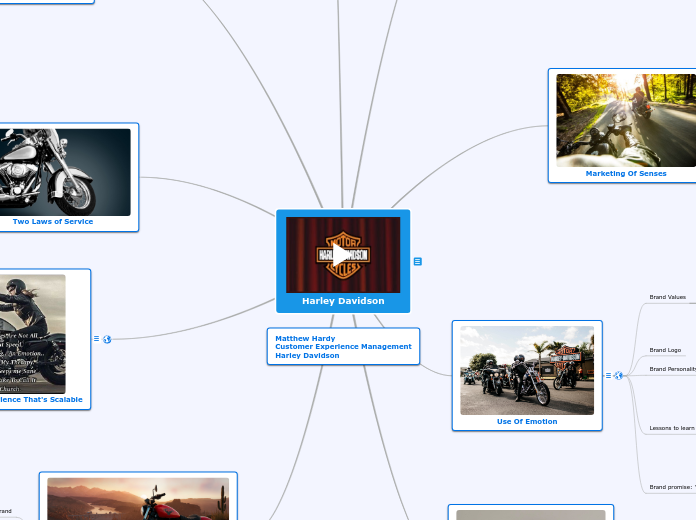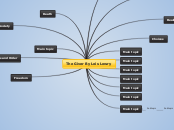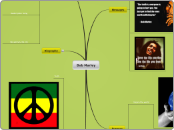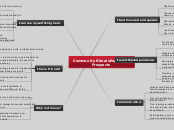Matthew Hardy
Customer Experience Management
Harley Davidson
Harley Davidson
I took the time to type out the script for this video because I believe almost every word captures the experience that Harley Davidson customers experience when interacting with the brand. I have highlighted what I believe to be the most important phrases.
Video script
When you drive a motorcycle, you experience the world around you in a more vivid way. You feel more alive when you’re on your bike. It is such as expression of personal identity. It’s about that individual expressing their individual personality, their style. And I think that passion, that sense of freedom is really what the brand is about and has been there right from the beginning. When you buy a Harley Davidson Motorcycle you really are buying a lifestyle. The purchase cycle didn’t end when you bought the bike; that was really the beginning of your experience with the brand. Willy G. Davidson famously said “We ride with you.” So, it created these families, these connections, because you start talking about freedom and independence. Well that cuts across all socioeconomic and demographic boundaries and classifications. It can bring people together. So, it’s a pretty remarkable power that the brand has in that way. The brand has remained true to what it stands for throughout all the ups and downs and it’s so genuine and authentic, and I think that’s why it’s been around for more than 100 years.
A customer-centric strategy always starts with the customer's needs. Harley Davidson has truly recognised the needs of its customers and designed experiences exclusively to meet those needs and exceed expectations.
Application Of Schmitt's 10 Principles
Given the time-constraints of this mind-map presentation, I will expand upon three of Schmitt's principles below.
- Experiences don't come randomly. They have to be planned.
- Starting point should be the customer experience
- Be obsessive about the details
- Find out the rubber ducky for your brand - it could be argued that the rubber ducky for Harley Davidson is its Harley Owner's Group, or HOG family. Once a customer has bought a Harley, they are immediately admitted into an exclusive member of like-minded product and experience-lovers. This is extremely powerful and promotes extremely loyal customers. The tribal nature of such a group also promotes the purchase of merchandise (such as Jackets and other outerwear), where customers are able to actively become brand ambassadors, while at the same time are able to define their personalities and style.
- Think about the user experience, not about your product or service - Harley Davidson builds motorcycles, but creates memorable experiences. Arguably, the experience of riding, alone or within a HOG family, is what customers buy. They don't simply buy a motorcycle.
- Try to offer holistic experiences, surprising your customer's sense
- Build up different kinds of experiences
- Use a consistent methodology - Harley Davidson has relied upon the experience created through its brand since its inception. The brand's identify has remained constant, and its customer base has largely remained loyal. Even though the company faces new challenges, such as the introduction of electric motor vehicles into the market, the company will keep the customer at the centre of its product and experience design strategy to ensure consistency in the experiences provided to customers.
- Offer omni-channel experiences
- Add dynamism and personality to your brand
Use a consistent methodology
Think about the user experience, not about
your product or service
Find the rubber ducky for your brand
Building An Experience That's Scalable
No need to listen to the entire podcast (it is 33 mins). The key features to take out of this article/podcast can be extracted from the below quotes:
“What we see from our customers – and the passion that we generate when experiencing the product – is not just the machine; it's about the freedom.”
The Harley Davidson experience
“What we see from our customers – and the passion that we generate when experiencing the product – is not just the machine. It's about the freedom, the expression of individualism through riding a motorcycle, riding a heavyweight motorcycle and riding a Harley-Davidson. Whenever we talk to our consumers about what's the value in the experience, it's that freedom. It's that emotional passionate response they have to being out and about on a motorcycle.
“Because in today's world, it's great to be on your smartphone but we all want to escape from it sometimes. That's something as an avenue that Harley-Davidson can deliver upon. We want to make sure that people get that experience and get the social aspects of that experience because it's not just an escape, it's an escape with your friends. There is more to it than just jumping on a bike.
“Now of course, there's plenty of us who enjoy actually getting away and riding on our own, but that engagement with other riders who share your passion, that just deepens the bond.”
The value of a bricks and mortar channel
“To be relevant, you need to be present. What we're working on is making sure that we have a brick and mortar channel that's represented to get our brand in front of people where they're shopping in these mall environments because it lowers the barrier to engaging with the brand. And you don't have to try and get them to go to to our dealerships. You're bringing the brand to them.”
A scalable experience
“Dealerships are the focal point of where we want people to experience the Harley-Davidson touch-points, but you don't always have a dealership close to you. How do we build a platform or an experience that's scalable, that you can experience Harley-Davidson in your city, whatever it maybe?
“All across the world actually we run Dark Custom tours or demo tours, whatever you want to call them. Essentially it's a truck full of motorcycles and Harley-Davidson accessories and related products that shows up in your town and you can come down and test a Harley-Davidson and test the life and see if it actually fits. Whether you try on a leather jacket and it fits you or whether you try on a motorcycle and it fits you, you can experience Harley-Davidson. […]
“It's a stationary test but you can go through the gears and you can really see the smile come across their face like, ‘Oh, this is what it feels like’. That's the beginning of their journey. It's fantastic.”
Avoiding silos
Harley Davidson includes Centres of Excellence, design teams, marketing, dealership representatives as well as all supporting units when designing customer experiences. It effectively builds cross-functional teams to ensure that the customer remains at the centre of all strategy definition and implementation.
Scalable experience
The Value of the bricks and mortar channel
The Harley Davidson Experience
Two Laws of Service
Try not to fail the customer twice
Harley Davidson has a H.O.G customer care service centre committed to caring exclusively for Harley owners.
Research, however, indicates that Harley Davidson might be letting down customers through less than optimal customer service standards. There is inherent risk when creating such an emotional brand affiliation to customers, whereby customers feel so emotionally attached and engaged by a brand and in circumstances where things go wrong, emotions are often heightened and any minor set-backs can be amplified.
Satisfaction = Perceptions - Expectations
https://www.youtube.com/watch?v=_D9QwlswSD8
Harley Davidson provides 'Bronze Star & Shield' awards to dealerships that go above and beyond to exceed expectations in terms of dealer performance and customer satisfaction. This illustrates Harley Davidson's commitment to designing experiences that exceed customer expectations and therefore increase satisfaction.
https://www.harley-davidson.com/us/en/about-us/hd-news/2018/harley-davidson-accelerates-strategy-to-build-next-generation-of-riders-globally.html
The above video illustrates how Harley Davidson is redefining and redesigning their customer experiences centred around its core values and mission.
CXM & Storytelling
The article from CMO.com lists six brands that have 'mastered the art of storytelling'.
One of these brands is Harley Davidson, with particular reference to its summer internship promotional video content.
Harley Davidson, like many other brands, has recognized the value of brand ambassadorship and is capitalizing on this through storytelling. This re-enforces Harley Davidson's dedication to understanding the customer and leveraging platforms such as social media to create the next generation of brand loyalists.
By integrating the customer into broader brand experiences than simple product purchase and use, the brand is able to expand its reach and demand the attention of those who are exposed to the brand's story.
Integrating a content-led competition into the human resources function, alongside social media is an extremely integrated approach to story-telling. Harley Davidson has the added benefit of portraying a young person enjoying the thrill of owning a Harley Davidson motorcycle to assist in capturing the targeted younger demographic in order to stay relevant.
Conclusions
The use of mind-mapping
I believe mind mapping is an excellent way to spark creativity, link ideas in a visual way and can allow the identification of relationships between different variables and data-sets. This exercise has allowed me to exhaustively analyze Harley Davidson's customer-centricity from a number of viewpoints. It has also allowed me to visually represent different frameworks and their impacts on the organization.
Harley Davidson's strengths
As mentioned throughout this mind map, Harley Davidson is an extremely customer-centric organization devoted to its loyal customer base. The organization designs experiences tailored exclusively to the customer segments which it knows intimately and inspires the utmost loyalty. Harley Davidson effectively leverages the impacts of the human senses in designing experiences and products. Likewise, it builds a brand image closely linked to emotion and effectively manages to keep a consistency in this approach. Harley Davidson has managed to build an extremely scalable experience and has effectively leveraged technology in the continuation of its customer-centric strategy.
Areas of improvement and risks
As mentioned, Harley Davidson has room for improvement in service design with regards to after-sale customer care. With highly emotive brands comes significant responsibility to keep loyal customers happy. Harley Davidson needs to understand that the pain points associated with motorcycle repair and maintenance are extremely important ans can have lasting negative impacts on the brand.
Harley Davidson also faces a significant challenge of a fundamental change to the market sentiment regarding petroleum-driven vehicles. As Harley Davidson explores and releases new technological enhancements in its migration to a mix of petroleum and battery-powered motorcycles, the brand will need to ensure its customer-experience sits at the heart of its migration strategy.
There also seems to be a market trend in terms of a decreasing demand for large motorcycles. If Harley Davidson can effectively adapt its motorcycle portfolio to include an increasing number of smaller motorcycles whilst still remaining true to the brand values of passion, freedom and heritage, then it can continue to leverage the immense power created from experience design methodologies.
4 Capabilities Of Experience Design
A great example of how Harley Davidson places significant value on experience design is the product-comparison tool built for prospective purchasers of a Harley Davidson motorcycle.
http://www.davidandrewgrant.com/home/2018/3/29/harley-davidson
A brief analysis of the wire frames illustrates how intimately Harley Davidson knows its customers and builds experiences tailored specifically for them. Harley Davidson knows the customization lies at the core of its value proposition and creates journeys that integrates customization at every touch point. It also understands the pain points involved when selecting dealerships and selecting relevant motorcycles to test ride. This provides contextual interaction to the customers and builds trust and demands loyalty.
Having order processes automated through the dealership speeds up waiting periods, and further reduces pain points. Harley Davidson understands that the most important aspect to a customer who has recently placed an order for a motorcycle is the time it takes to get on and ride it.
Journey Innovation
Contextual interaction
Proactive personalisation
Automation
Use Of Emotion
"While Harley Davidson products might be automotive in nature, the brand isn’t interested in just selling motorbikes. Harley can’t compete with the quality and prices of the other bikes available on the market, which generally have more advanced mechanics and lower price tags. That’s why the director of communications in the 90's decided to transform the brand into one centered around emotion.
Harley Davidson brand ambassadors don’t just buy bikes – they believe they’re purchasing passion, freedom, power, individualism, and courage. The roar of the Harley helps customers to truly come to life on the road, as they share their experiences with other members of a large, global family. Unlike other manufacturers, Harley Davidson teaches us the value of using the emotions that are associated with your brand."
Source:
http://fabrikbrands.com/born-in-the-usa-harley-davidson-brand-story/
Brand promise: "A journey like no other."
Lessons to learn
Always learn more about your customer
Sell a lifestyle, not a product
Emotions are powerful:
Learn how to use them
Create a community, but don't be
restricted by it
Brand Personality
Brand Logo
Brand Values
Quality
Community
Heritage
Freedom
Marketing Of Senses
The Powerful Emotional Appeal
Though Harley Davidson products might look automotive, the brand is not focused on selling motorcycles. Harley Davidson simply cannot compete with the quality of other bikes on the market – especially those coming from Japan and Korea, which tend to be less expensive and sometimes have more advanced mechanics. Therefore, in the ‘80s and ‘90s, then-Director of Communications, Ken Schmidt decided to transform Harley Davidson into an emotional brand.
The Use of senses
Harley Davidson arguably targets every single one of the human senses (perhaps with the exclusion of taste) when designing user experiences. The below will give a brief explanation of how Harley Davidson uses sound, sight, touch, and smell to create strong emotional connections with its loyal customers.
Sound
This in undoubtedly one of the most powerful sensory aspects of the Harley Davidson brand. Harley Davidson purposely designs its engines so that they produce a sensory experience to the rider as well as those witnessing a Harley Davidson motorcycle drive past. A Harley engine, like most other motorcycle engines, has two pins. The difference in the Harley engine is that the crankshaft has only one pin, and both pistons connect to it. This design, combined with the V arrangement of the cylinders, means that the pistons cannot fire at even intervals.
Sight
Harley Davidson motorcycles are designed to look powerful, dark, awe-inspiring and free. They were originally designed for the rider to take on sprawling American highways and grant the rider a unique and highly emotional experience. The motorcycles' designs are unique, and coupled with the aforementioned sound effects, they can be identified from long distances away. Motorcycles are designed with the end users and the camaraderie that exists between them in mind.
Touch
With leather seats, chic and shiny part-covers and strong vibrations coming through the vehicle, riding a Harley can only be described as an unforgettable experience. Further, the design of the raised handlebars in most 'Low-rider' models, the feel of riding a Harley is unparalleled.
Smell
More of an accompanying sense, the sense of smell is included in the sensory experience through the smell of gasoline that is produced by a Harley Davidson. Because of the exhaust system as well as the position of certain parts, the smell is intended to be included in the sensory overload experienced by Harley Davidson riders.
Smell
Touch
Sight
Sound
The Customer Journey
In addition to the posted customer journey map on slideshare, below is a list of the 4 key factors for a memorable experience and how Harley Davidson delivers these factors exceptionally well.
Technology
Harley Davidson not only uses incredible sophisticated technology in its motorcycle and engine design in order to create unique experiences, but also uses technology to interact with its 'HOG Family' through digital communication platforms. A brief scroll through its Twitter account gives only a snapshot of this customer interaction. There are many other examples across not only social media, but also the dealerships' customer engagement strategies, which include organized rides, club meetings and social events.
Further, Harley Davidson is integrating technology into the dealership experience, with augmented reality experiences and virtual riding for those not old enough to ride. Further, the online shopping experience that has been developed by Harley allows it to interact with its customers and prospects effectively, decreasing any barriers created by distance.
https://twitter.com/harleydavidson
Personalization & Customization
Harley Davidson motorcycles are designed using modular technology, allowing parts and components to be uniquely customized for individual riders. This further exacerbates Harley's ability to create opportunities for its riders to portray their personalities, identities and style. In fact, there are competitions whereby custom Harley Davidson motorcycles are judged and rewarded based on their unique features, creativity and design.
Human Touch
This factor is embedded in two parts of the Harley Davidson experience. First, in the touch and feelings experienced when riding a Harley. From the feeling of the powerful engine, to the roaring sound of the exhaust, riding one is truly a unique experience. Second, the community, or 'family' aspect of owning a Harley Davidson is truly unique. In an age where humans are identifying even more closely with their 'tribes', Harley Davidson has given its loyal customer base a platform for human connectivity centered around shared dreams of passion and freedom.
Wow Factor
Wow factors are scattered throughout the experience of owning a Harley Davidson. As per the brand video central to this mind map, the wow factor of the initial purchase (riding the motorcycle out of the dealership) is only really the beginning of the customer experience. The freedom of riding on the open highways, the feeling of power in between the legs of the rider, the sense of community and camaraderie and every subsequent interaction with the brand demands a sense of 'wow' from the customer. This is exemplified in customers' willingness to not only buy the motorcycles as the central product, but also the adjacent products such as jackets and protective clothing to identify themselves as Harley drivers. In many ways, this type of brand loyalty is unique and highly desirable.
Wow Factor
Human Touch
Personalization & Customization
Technology
Customer Journey Map









